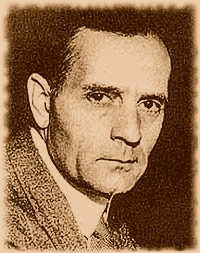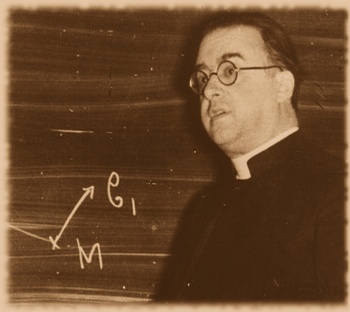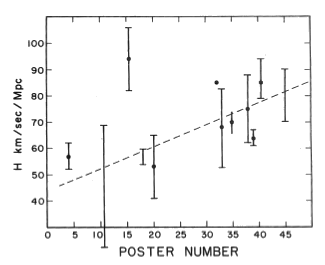Hubble and His Law
July 31, 2013
The
Internet is a great
laxative to relieve
editorial blockage. A recent example is an
arXiv posting, "Anybody but Hubble!" by noted
astronomer,
Virginia Trimble.[1] Trimble's paper was prepared for the
proceedings of a
conference at
Lowell Observatory in 2012, but it was rejected by the
editors. The paper is about the discovery of
Hubble's law, which expresses the rate of
expansion of the universe. A rejected paper by a noted
scientist has much more merit than other rejected papers, and such a rejection may actually increase the number of readers.
As I've noted in previous articles (for example,
Sexism in Science, September 28, 2012),
women scientists were rare in earlier times, but somewhat less rare after the middle of the
twentieth century. A 1962 article in
Life about
UCLA featured a
sophomore Trimble as an eighteen year-old
astrophysics student.[1] She received her
B.A. from UCLA in 1964, an
M.A. from
Cambridge University in 1969, and her
Ph.D. from
Caltech in 1968. Trimble joined the astronomy
faculty at the
University of California, Irvine, in 1971, where she remains. She was a
vice president of the
American Astronomical Society and the
International Astronomical Union.
Hubble's law is named after
American astronomer,
Edwin Hubble (1889-1953).
Hubble's was not really a
household name until the
Hubble Space Telescope (HST) was launched in 1990. The HST was launched with a
flawed mirror which was
spherically aberrant. The problem was solved with
corrective optics in a 1994 servicing mission. Many astronomers think that astronomer Hubble's claim to his law is also flawed, and it's this question that Trimble addresses in her paper. There's another arXiv paper that argues that this law was just one of several ideas appropriated by Hubble without attribution.[3]

Edwin Hubble (1889-1953)
During Hubble's lifetime, the Nobel Prize was withheld from astronomers; but, as astronomers started answering some important questions in physics, that changed.
(Photograph via Wikimedia Commons, modified for artistic effect.)
It's not unusual for great
scientific discoveries to be independently discovered by more than one
scientist. The reason for this is that science is
data-driven, and these data are freely available to all in the published
literature. Hubble made significant contributions to twentieth century
cosmology, including observations that the
recessional velocities of
galaxies increase with their distance from the
Earth, indicative of
universal expansion. Hubble, however, wasn't the only
cosmologist during the early part of the century.
It's been argued that
Georges Lemaître, a
Belgian priest and astronomer, discovered this law before Hubble; and, perhaps in a
humility that befitted his priestly calling, he published his 1927 paper on this idea in
French in a lesser known
journal where it was ignored.[4] An
English translation was published in 1931 in the
Monthly Notices of the Royal Astronomical Society (MNRAS); however, this was not an exact translation.[4]

Georges Lemaître (1894-1966)
Lemaître has a spacecraft named after him, as well as a lunar crater.
(Photograph via Wikimedia Commons, modified for artistic effect.)
Although Lemaître is the most cited example, Trimble lists many others who have been suggested as the originator of Hubble's law; viz.,
• Knut Lundmark, who was one of the first to work on the hypothesis that galaxies were not part of the Milky Way. Lundmark measured the distance to the Andromeda Galaxy in 1919.
• Willem de Sitter, creator of a relativistic mathematical model of the universe that allows for expansion.
• Vesto Slipher, who discovered galactic redshifts. Lemaître used Slipher's data in his 1927 paper.
• Alexander Friedmann, whose 1922 Friedmann equations provided a model for an expanding universe.
• Carl Wilhelm Wirtz, who observed galactic (then nebular) redshifts in 1918, publishing his results in 1922.
• Johann Karl Zoellner, who also worked on redshifts.
Much of the recent Lemaître-Hubble
controversy has centered on the idea that Hubble may have
censored Lemaître's MNRAS translation to retain
priority, since text about the recession law and some of the notes were missing.[5]
Astrophysicist,
Mario Livio, as related in an
interview with
Jennifer Ouellette, investigated the matter by examining the archived correspondence of the
Royal Astronomical Society, where he discovered that Lemaître, himself, had updated the article. Lemaître had deferred to Hubble's more complete work on the matter.[5]
Lemaître's 1927 paper calculated the
proportionality constant of the recessional velocity
vs distance relationship, which is now called the Hubble constant, to be 625
kilometers-per-second-per-
megaparsec (km/s/Mpc).[5] He had used data taken by astronomer Vesto Slipher. Hubble's 1929 paper contained additional data, and it produced a Hubble constant of 500 km/s/Mpc. Hubble didn't reference Lemaître's paper, probably because he had never seen it.
Trimble concludes that "Hubble's Law" is a proper designation.[2] I think that Lemaître deserves some credit as well, but not to the extent of changing the designation to "Lemaître's Law." The moral of the story is, "
Don't hide your lamp under a bushel basket." If Lemaître had originally published in a mainstream journal, the story might have been different.
One thing I enjoyed about Trimble's paper is fig. 3, shown below. In this
plot, the values of the Hubble constant for
poster papers at a 1995 conference are plotted as a function of poster number, which is derived from the
alphabetical ordering of the first author's name. Writes Trimble, "The
correlation is about as good as some of the others in cosmology."[2]

Correlation is in the eye of the beholder.
There is no apparent law that connects the value of the Hubble constant (H) and the abscissa of this plot.
(Fig. 3 of ref. 2, via arXiv.)[2]
![]()
References:
- "Behind a Lovely Face, a 180 I.Q.," Life Magazine, October 19, 1962, pp. 98-99.
- Virginia Trimble, "Anybody but Hubble!" arXiv Preprint Server, July 8, 2013.
- Michael J. Way, "Dismantling Hubble's Legacy?" arXiv Preprint Server, January 30, 2013.
- Jean-Pierre Luminet, "Editorial note to "A Homogeneous Universe of Constant Mass and Increasing Radius accounting for the Radial Velocity of Extra--Galactic Nebulae" by Georges Lemaître (1927)," arXiv Preprint Server, May 28, 2013.
- Jennifer Ouellette, "Q&A With Astrophysicist Mario Livio on Brilliant Blunders," Cocktail Party Physics, May 29, 2013.
Permanent Link to this article
Linked Keywords: Internet; laxative; editor-in-chief; editorial; arXiv; astronomer; Virginia Trimble; proceedings; conference; Lowell Observatory; editor; Hubble's law; metric expansion of space; expansion of the universe; scientist; women scientist; 20th century; twentieth century; Life magazine; University of California, Los Angeles; UCLA; sophomore; astrophysics; Bachelor of Arts; B.A.; Master of Arts; M.A.; Cambridge University; Doctor of Philosophy; Ph.D.; California Institute of Technology; Caltech; faculty; University of California, Irvine; vice president; American Astronomical Society; International Astronomical Union; American; Edwin Hubble (1889-1953); celebrity; household name; Hubble Space Telescope; flawed mirror; spherical aberration; spherically aberrant; corrective optics; Nobel Prize; physics; Wikimedia Commons; science; scientific; scientist; data-driven; scientific literature; physical cosmology; recessional velocity; galaxy; Earth; metric expansion of space; universal expansion; cosmologist; Georges Lemaître; Belgium; Belgian; Priesthood Catholic Church; priest; humility; French; scientific journal; English language; translation; Monthly Notices of the Royal Astronomical Society; spacecraft; lunar crater; Knut Lundmark; hypothesis; Milky Way; Andromeda Galaxy; Willem de Sitter; theory of relativity; relativistic; mathematical model; Vesto Slipher; redshift; Alexander Friedmann; Friedmann equations; Carl Wilhelm Wirtz; nebula; nebular; redshift; Johann Karl Zoellner; controversy; censorship; censored; scientific priority; astrophysicist; Mario Livio; interview; Jennifer Ouellette; Royal Astronomical Society; proportionality constant; kilometers-per-second; megaparsec; Don't hide your lamp under a bushel basket; plot; poster paper; alphabetical order; correlation; abscissa.